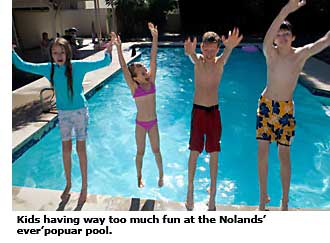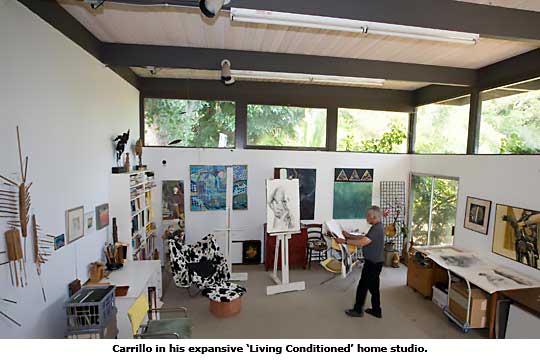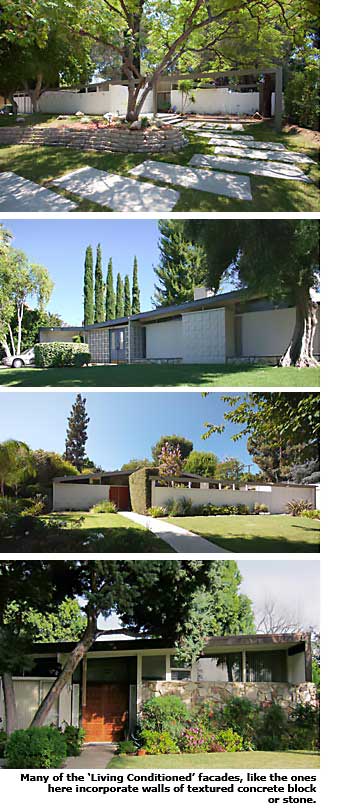'Living Conditioned' Homes of Northridge - Los Angeles - Page 3
"Advertising puffery," Krisel says—though 'cottage cheese ceilings' did help lower noise and tinted windows fought glare. "If you think living conditioned, he adds, "that means 'for living.'" The homes were not originally air-conditioned.
No one calls the neighborhood 'Living Conditioned' today—only the historically minded recall the name. "I don't think it has a name," Biessels says of the tract.

According to a 1957 advertisement, these were 'homes that are keyed to good living, providing the greatest degree of comfort, livability, and convenience.'
They provided space conditioning, which dealt with 'the relationship of...space to comfortable living': sound conditioning, using 'acoustical planning' to reduce noise; 'light conditioning to eliminate glare and shadow'; and safety conditioning to produce a 'scientifically planned house' with 'dependable mechanical equipment.'
There was also climate conditioning, and 'color conditioning...blended to provide harmony as well as excellent backgrounds for family furnishings.' Safety conditioning came in handy at 4:31 a.m. January 17, 1994, when a 6.7 magnitude earthquake sent neighbors scurrying into the street. "We ran out to Reseda Boulevard," Vanessa Brown recalls. "It was a 52-foot wave."
"We saw the cars bouncing up and down," Bruce Madden says.
The Northridge Quake killed dozens and injured thousands, pancaking one nearby apartment building where 16 died, and collapsing the Northridge Fashion Center mall. Madden raced through the neighborhood turning off people's gas. "I was scared to death," he says. "Guys were smoking and gas was pouring out."

In the quake, 'Living Conditioned' homes lost many fireplaces and shelves and most suffered some damage. Lois Jones says her house suffered $159,000 in damages. "The pool emptied into the house," she says. She still has sliding-glass doors that don't slide, a common complaint post-quake.
For months, Madden says, his two teenaged daughters were too spooked to sleep in their own bedrooms; they slept on their parents' bedroom floor. But the neighborhood pulled through, he says. "I didn't see any big, massive exodus."

That's a tribute to the neighborhood's appeal. The homes are on large lots; Tracey Hassleim's is 11,000 square feet. And, as neighbors point out, most houses are miraculously arrayed on their lots so views from the backyard reveal, not other houses, but trees and the distant mountains. "It's like you're in the country," says Rose Brown, Vanessa's mother.
The streetscape is varied and attractive. There are butterfly roofs, low gables, and flat roofs; attached and detached garages, and carports. Many homes have walled-in, pocket courtyards fronting the master bedroom. Some homes have atrium-like entry courtyards.
Many facades incorporate walls of textured concrete block or stone. In some homes the walls extend beyond the length of the home itself as freestanding objects. Houses with stone or concrete block outside have the same material inside as well.
Louvered windows were common, though many have been replaced. Many homes have double-doors, and some have doors that extend the height of the façade.
Kitchens, often U-shaped, are in the center of the house. Slide-away, shoji-like screens separate living space from a family room. Many homes retain such charming touches as iridescent blue kitchen counter tiles and built-in kitchen blenders.
People are paying a lot more attention to these details since the Nolands arrived. "They sort of instigated this interest in architecture," Hassleim says. The Nolands began their educational campaign with a party that attracted about 25 people and featured a talk by architectural historian Alan Hess. Gemma hopes the next event will include open houses at several homes.
"Everyone who has come to our house for the parties has been 100 percent enthusiastic," Gemma says.
Gemma and Mark, who see their neighborhood with lovers' eyes, say that 90 percent of the homes in their tract are essentially original—or could be made so. "The right person," Mark says, "could go in and make the proper changes."
One person who shares the spirit is their daughter, Frances. "Hopefully," she says, "I'm going to buy up the whole neighborhood and make all the houses original."
• The Northridge 'Living Conditioned Homes' neighborhood is located at the northeastern corner of Reseda Boulevard and Devonshire Street. Its homes can be found on Reseda and Devonshire, and on Minehaha, Hiawatha, Blackhawk, and San Jose streets and Canby Avenue.
Photos: John Eng and Dave Weinstein
- « first
- ‹ previous
- 1
- 2
- 3




